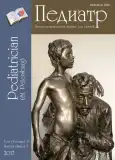Особенности острого периода черепно-мозговой травмы у детей с гемофилией
- Авторы: Гузева В.И.1, Охрим И.В.1, Максимова Н.Е.1, Гузева О.В.1, Гузева В.В.1, Абрамова Н.Н.1, Родионов Ю.В.1
-
Учреждения:
- ФГБОУ ВО «Санкт-Петербургский государственный педиатрический медицинский университет» Минздрава России
- Выпуск: Том 8, № 3 (2017)
- Страницы: 158-163
- Раздел: Статьи
- URL: https://ogarev-online.ru/pediatr/article/view/6712
- DOI: https://doi.org/10.17816/PED83158-163
- ID: 6712
Цитировать
Полный текст
Аннотация
Клиническая картина черепно-мозговой травмы (ЧМТ) у детей характеризуется выраженным полиморфизмом. Для уточнения степени тяжести ЧМТ и локализации патологического процесса используют компьютерную томографию (КТ) или магнитно-резонансную томографию (МРТ) головного мозга.
Целью работы явилось обоснование необходимости проведения нейровизуализации всем детям с гемофилией при ЧМТ и определение корреляции между степенью тяжести клинических проявлений и нейровизуализационными данными. В статье описан клинический случай благоприятного исхода ЧМТ у ребенка ясельного возраста с гемофилией А. Случай представляет интерес для врачей различных специальностей и демонстрирует особенности клинического течения острого периода ЧМТ на фоне гемофилии. Диагностический процесс при ЧМТ базировался на жалобах, клинических и нейровизуализационных данных. В связи с ранним возрастом ребенка и отсутствием сформированной речи жалобы и обстоятельства получения травмы известны со слов матери.
Методы исследования: жалобы и анамнез заболевания, общесоматический и неврологический осмотры, лабораторные, инструментальные и нейровизуализационные данные. Известно, что мальчик упал с дивана, ударился затылком, сознание не терял, рвоты не было. Через сутки после получения травмы наблюдалось нарастание общемозговой неврологической симптоматики. Клинически заподозрена гематома. На КТ головного мозга определялась эпидуральная гематома. Таким образом, представленный клинический случай иллюстрирует, что даже легкая травма головы у больных с гемофилией может привести к тяжелым последствиям. Нейровизуализация головного мозга при ЧМТ показана детям с гемофилией вне зависимости от степени выраженности клинических проявлений в остром периоде травмы.
Ключевые слова
Полный текст
Открыть статью на сайте журналаОб авторах
Валентина Ивановна Гузева
ФГБОУ ВО «Санкт-Петербургский государственный педиатрический медицинский университет» Минздрава России
Автор, ответственный за переписку.
Email: viktoryka@mail.ru
д-р мед. наук, профессор, заведующая, кафедра нервных болезней
Россия, Санкт-ПетербургИнна Владимировна Охрим
ФГБОУ ВО «Санкт-Петербургский государственный педиатрический медицинский университет» Минздрава России
Email: ochrim@yandex.ru
канд. мед. наук, ассистент, кафедра нервных болезней
Россия, Санкт-ПетербургНадежда Евгеньевна Максимова
ФГБОУ ВО «Санкт-Петербургский государственный педиатрический медицинский университет» Минздрава России
Email: maximov53@mail.ru
ассистент, кафедра нервных болезней
Россия, Санкт-ПетербургОксана Валентиновна Гузева
ФГБОУ ВО «Санкт-Петербургский государственный педиатрический медицинский университет» Минздрава России
Email: viktoryka@mail.ru
д-р мед. наук, профессор, кафедра нервных болезней
Россия, Санкт-ПетербургВиктория Валентиновна Гузева
ФГБОУ ВО «Санкт-Петербургский государственный педиатрический медицинский университет» Минздрава России
Email: viktoryka@mail.ru
д-р мед. наук, профессор, кафедра нервных болезней
Россия, Санкт-ПетербургНаталья Николаевна Абрамова
ФГБОУ ВО «Санкт-Петербургский государственный педиатрический медицинский университет» Минздрава России
Email: abrnatalia@yandex.ru
отделение анестезиологии и реанимации
Россия, Санкт-ПетербургЮрий Викторович Родионов
ФГБОУ ВО «Санкт-Петербургский государственный педиатрический медицинский университет» Минздрава России
Email: rodjv@mail.ru
отделение микрохирургии
Россия, Санкт-ПетербургСписок литературы
- Гузева В.И. Детская неврология. Вып. 3: клинические рекомендации. – М.: ООО «МК», 2015. – 336 с. [GuzevaVI. Detskaya nevrologiya. Vol. 3: Klinicheskie rekomendatsii. Moscow: MK; 2015. 336 p. (In Russ.)]
- Кондаков Е.Н., Кривецкий В.В. Черепно-мозговая травма. – CПб.: СпецЛит, 2002. – 271 c. [Kondakov EN, Krivetskiy VV. Cherepno-mozgovaya travma. Saint Petersburg: SpetsLit; 2002. 271 p. (In Russ.)]
- Непомнящий В.П., Лихтерман Л.Б., Ярцев В.В. Эпидемиология черепно-мозговой травмы и ее последствий // Клиническое руководство по черепно-мозговой травме. – М.: Антидор, 1998. – Т. 1. – C. 129–151. [Nepomnyashchiy VP, Likhterman LB, Yartsev VV. Epidemiologiya cherepno-mozgovoy travmy i ee posledstviy. In: Clinical Guide to Craniocerebral Trauma. Moscow: Antidor; 1998. Vol. 1. P. 129-151. (In Russ.)]
- Потапов А.А., Лихтерман Л.Б., Зельман В.Л., и др. Доказательная нейротравматология. – М., 2003. – 517 с. [Potapov AA, Likhterman LB, Zel’man VL, et al. Dokazatel’naya neyrotravmatologiya. Moscow; 2003. 517 p. (In Russ.)]
- Валиуллина С.А., Промыслова Е.А., Фуфаева Е.В., Кузьминова Т.А. Реабилитация детей с черепно-мозговой травмой: состояние, проблемы, перспективы // Детская и подростковая реабилитация. – 2011. – № 1. – C. 13–21. [Valiullina SA, Promyslova EA, Fufaeva EV, Kuz’minova TA. Reabilitatsiyadetey s cherepno-mozgovoytravmoy: sostoyanie, problemy, perspektivy. Rehabilitation of children with traumatic brain injury: state-of-art, problems, perspectives. Child and adolescent rehabilitation. 2011;(1):13-21. (In Russ.)]
- Гузева В.И., Максимова Н.Е., Касумов В.Р., Ляпин А.П. Черепно-мозговая травма у детей первого года жизни. Научно-практическая конференция. Современная фармакотерапия. Интеллектуальная игра для неврологов. Загадки мозга: сборник докладов. – СПб., 2017. – С. 27–28. [Guzeva VI, Maksimova NE, Kasumov VR, Lyapin AP. Сherepno-mozgovaya travma u detey pervogo goda zhizni. [conference proceedings]. Modern pharmacotherapy. Intellectual game for neurologists. Mysteries of the brain: a collection of reports. Saint Petersburg; 2017. P. 27-28. (In Russ.)]
- Коновалов А.Н., Лихтерман Л.Б., Потапов А.А. Нейротравматология: Справочник. – 2-е изд. – Ростов н/Д: Феникс, 1999. – 576 c. [Konovalov AN, Likhterman LB, Potapov AA. Neyrotravmatologiya: Spravochnik. 2nd ed. Rostov n/D: Feniks; 1999. 576 p. (In Russ.)]
- Королев А.Г. Черепно-мозговая травма у детей грудного и раннего возрастов: Автореф. дис. … канд. мед. наук. – M., 1991. [Korolev AG. Cherepno-mozgovaya travma u detey grudnogo i rannego vozrastov [dissertation]. Moscow; 1991. (In Russ.)]
- Форбе К., Лев М.Х., Шетти С., Хейзермани Дж. Нейровизуализация: иллюстр. пособие. – М.: МЕДпресс-информ, 2010. – 224 с. [Forbe K, Lev MKh, Shetti S, Kheyzermani Dzh. Neyrovizualizatsiya: illyustr. posobie. Moscow: MEDpress-inform; 2010. 224 p. (In Russ.)]
- Зозуля Н.И., Свирин П.В., Савченко В.Г. Клинические рекомендации по диагностике и лечению гемофилии. – М., 2014. – 41 с. [Zozulya NI, Svirin PV, Savchenko VG. Klinicheskie rekomendatsii po diagnostike i lecheniyu gemofilii. Moscow; 2014. 41 p. (In Russ.)]
- Djulbegovic B, Goldsmith GH Jr. Guidelines for management of hemophilia A and B. Blood. 1995;85(2):597-9.
- Russel Jesse, Cohn Ronald. Acquired brain injury. Bookvikapublishing; 2012. 84 p.
- Astermark J, Petrini P, Tengborn L, et al. Primary prophylaxis in severe haemophilia should be started at an early age but can be individualized. Br J Haematol. 1999;105: 1109-13. doi: 10.1046/j.1365-2141.1999.01463.x.
- Mahoney EJ, Biffl WL, Harrington DT, Cioffi WG. Isolated brain injury as a cause of hypotension in the blunt trauma patient. J Trauma. 2003;55(6):1065-9. doi: 10.1097/01.TA.0000100381.89107.93.
Дополнительные файлы







